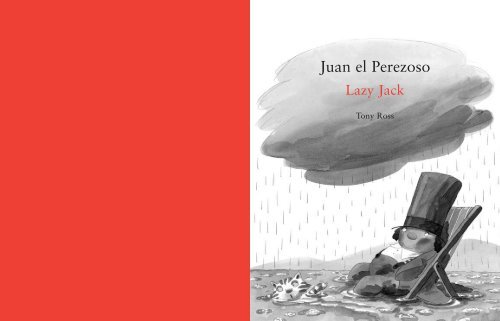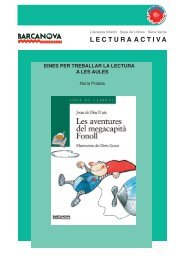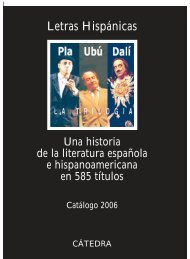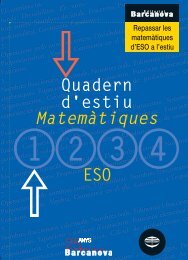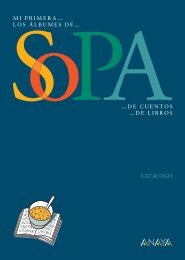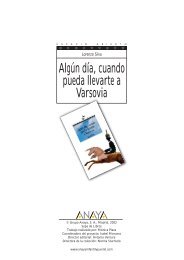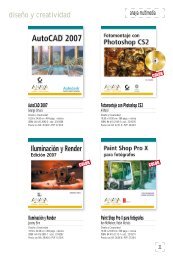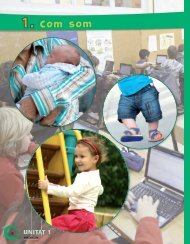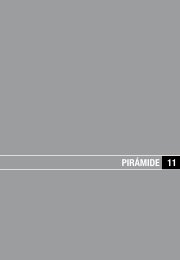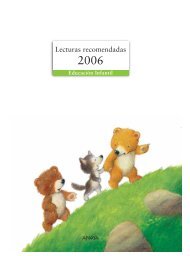Juan el Perezoso
Juan el Perezoso - Barcanova
Juan el Perezoso - Barcanova
You also want an ePaper? Increase the reach of your titles
YUMPU automatically turns print PDFs into web optimized ePapers that Google loves.
<strong>Juan</strong> <strong>el</strong> <strong>Perezoso</strong><br />
Lazy Jack<br />
Tony Ross
Lazy Jack<br />
<strong>Juan</strong> <strong>el</strong> <strong>Perezoso</strong><br />
There is a boy called Jack who lives with his mother.<br />
Jack is probably the laziest person in the world,<br />
and he just sits around while his mother does<br />
all the work.<br />
But Jack’s mother can stand no more of his laziness,<br />
and says to him: “Get out and get a job!”<br />
Hay un niño llamado <strong>Juan</strong>, que vive con su madre.<br />
Probablemente, <strong>Juan</strong> es la persona más gandula<br />
d<strong>el</strong> mundo, y se sienta sin más, mientras su madre hace<br />
toda la tarea. Pero la madre de <strong>Juan</strong> no puede aguantar<br />
más su gandulería, y le dice: «¡Sal fuera y consigue<br />
un trabajo!».<br />
The Author<br />
Born in 1938 in Wandsworth, South London, Tony Ross never thought<br />
about a career in art, but says he f<strong>el</strong>l into it after his dream of being a<br />
cowboy disintegrated when a letter he wrote to John Wayne was never<br />
replied to! His first book was published in 1976. As w<strong>el</strong>l as his own books,<br />
he has illustrated books for authors such as Roald Dahl, Paula Danziger<br />
and Micha<strong>el</strong> Palin. Multi-award-winning Tony Ross has become one of the<br />
best-known creators of original and traditional picture books and his work<br />
has been published all over the world.<br />
El autor<br />
Tony Ross nació en 1938 en Wandsworth, al sur de Londres. Nunca pensó<br />
en dedicarse al arte, pero, según dice, acabó haciéndolo después de que su<br />
sueño de convertirse en un vaquero se esfumase al no recibir respuesta<br />
alguna a una carta que escribió a John Wayne. Su primer libro se publicó<br />
en 1976. Además de sus propias obras, ha ilustrado textos de otros autores,<br />
como Roald Dahl, Paula Danziger y Micha<strong>el</strong> Palin. Ganador de numerosos<br />
premios y reconocimientos, Tony Ross se ha convertido en uno de los más<br />
famosos creadores de álbumes infantiles, y su obra ha sido publicada<br />
en numerosos idiomas en <strong>el</strong> mundo entero.<br />
Learning Objectives<br />
Objetivos didácticos<br />
• To promote listening and observational skills.<br />
• To recall information from a story.<br />
• To show an awareness of story structure and to practise general<br />
reading skills.<br />
• To predict what will happen in a story.<br />
• To dev<strong>el</strong>op an awareness of rhyming words and sp<strong>el</strong>ling patterns.<br />
• To teach or revise some adjectives; lazy, angry, hungry, sad.<br />
• Desarrollar las habilidades visuales y auditivas.<br />
• Recabar información de una historia.<br />
• Familiarizarse con esquemas narrativos y fomentar la comprensión<br />
lectora.<br />
• Anticiparse a lo que sucederá en <strong>el</strong> r<strong>el</strong>ato.<br />
• Familiarizarse con las rimas y las estructuras gramaticales.<br />
• Aprendizaje y repaso de algunos adjetivos: lazy, angry, hungry, sad.<br />
69<br />
70
Lazy Jack<br />
<strong>Juan</strong> <strong>el</strong> <strong>Perezoso</strong><br />
Introduction<br />
• Before you introduce the story to the class cover up the words lazy and perezoso in<br />
the title with pieces of paper. Show the cover of the book to the children and ask<br />
them to t<strong>el</strong>l you what they can see. Why do they think the boy is sitting in the rain?<br />
T<strong>el</strong>l the class that the boy’s name is Jack and that the covered up words describe him<br />
Write up some possible adjectives on the board (angry, sad, lazy, hungry etc), act out<br />
or explain their meanings, and ask the class to choose the one they think could best<br />
describe Jack. Ask a volunteer to come out and uncover the words and check if they<br />
have guessed correctly.<br />
• Ask the children to predict what the story will be about. What will Jack do? When<br />
the children respond in their native language translate their ideas in your response;<br />
Lucas thinks Jack will learn not to be lazy.<br />
• Can they t<strong>el</strong>l you who the author is? Do they know any other books by Tony Ross?<br />
Reading the Story<br />
• Read the story pausing for the children to see the illustrations. Use expression and<br />
gestures to exaggerate what the characters say especially Jack’s mother when she is<br />
angry with her son.<br />
• Stop at page 15 and ask the class what they think Jack will do with the cheese and<br />
then later at page 24 when he is given a donkey. Make sure the children understand<br />
what is happening and why Jack always gets into trouble with his mother.<br />
• At page 25 stop and ask the children if they remember the princess at the beginning<br />
of the book. Can they guess how she and Jack will meet?<br />
Introducción<br />
• Antes de presentar <strong>el</strong> libro a la clase, tapamos las palabras «lazy» y «perezoso» en <strong>el</strong><br />
título con trozos de pap<strong>el</strong>. Enseñamos la cubierta d<strong>el</strong> libro a los niños, y les pedimos<br />
que digan lo que ven. ¿Por qué creen <strong>el</strong>los que <strong>el</strong> personaje está sentado bajo la lluvia?<br />
Contamos a los alumnos que <strong>el</strong> nombre d<strong>el</strong> personaje es <strong>Juan</strong>, y que las letras<br />
que hemos tapado le describen. Escribimos algunos posibles adjetivos en la pizarra<br />
(angry, sad, lazy, hungry, etc.), representamos o explicamos sus significados, y pedimos<br />
a los alumnos que <strong>el</strong>ijan aqu<strong>el</strong> que piensen que puede describir a <strong>Juan</strong>. Pedimos<br />
un voluntario para que salga y destape las palabras de la cubierta, y comprobamos si<br />
han acertado.<br />
• Pedimos a los niños que imaginen de qué puede tratar la historia. What will Jack do?<br />
Cuando los niños respondan en cast<strong>el</strong>lano, traducimos sus ideas al inglés: Lucas<br />
thinks Jack will learn not to be lazy.<br />
• ¿Pueden los alumnos decir quién es <strong>el</strong> autor d<strong>el</strong> libro? ¿Conocen otras obras de<br />
Tony Ross?<br />
Durante la lectura<br />
• Leemos la historia, dejando tiempo para que los niños observen las ilustraciones.<br />
Usamos expresiones y gestos para exagerar lo que los personajes dicen, especialmente<br />
la madre de <strong>Juan</strong>, cuando se enfada con su hijo.<br />
• Nos detenemos en la página 15 y pedimos a los alumnos que imaginen lo que <strong>Juan</strong><br />
hará con <strong>el</strong> queso. Luego vamos a la página 24 y realizamos <strong>el</strong> mismo ejercicio con<br />
<strong>el</strong> burro. Debemos asegurarnos de que los niños entienden lo que está sucediendo,<br />
y por qué <strong>Juan</strong> siempre se lleva regañinas de su madre.<br />
• Nos detenemos en la página 25 y preguntamos a la clase si recuerdan a la princesa d<strong>el</strong><br />
comienzo d<strong>el</strong> cuento. ¿Pueden imaginar de qué manera se encontrarán <strong>Juan</strong> y <strong>el</strong>la?<br />
71<br />
72
Lazy Jack<br />
<strong>Juan</strong> <strong>el</strong> <strong>Perezoso</strong><br />
Follow-up Activities<br />
Memory<br />
Can the class remember where Jack puts the presents he is given? Show the class the<br />
pictures again and ask them to t<strong>el</strong>l you where he puts each item. Make a list on the<br />
board; in his trouser pocket, in his jacket pocket, on his head, in his arms, on a string,<br />
on his back. Without looking at the pictures again, can the class remember all the presents<br />
he is given? What does he put in his trouser pocket? What does he put on his head?<br />
Jack Says<br />
Explain to the children that they must follow the instructions only when they start<br />
with ‘Jack says’ i.e. Jack says put your hands on your head (the children put their hands<br />
on their head), put you hands down (the children should not put their hands down).<br />
Confident children can be encouraged to take turns to give the instructions for the<br />
other children to follow.<br />
Does it rhyme?<br />
Write Jack on the board. Point out the «ck» ending and explain that this sound is often<br />
found at the end of words in English. Do they know anymore words with this sp<strong>el</strong>ling<br />
pattern? H<strong>el</strong>p them to think of some more with verbal and visual clues i.e. A colour<br />
(black), a part of your body (back), where Santa carries his toys (sack). Teach them<br />
some more words which rhyme with Jack i.e. track and pack and write them up on the<br />
board. Add some more words which are complet<strong>el</strong>y different i.e. baby or house.<br />
Explain that you are going to play a game where they have to listen very carefully and<br />
only stand up if they hear a word which rhymes (has the same final sound) as Jack. If<br />
it doesn’t rhyme they must sit down. Say a list of words including some which do not<br />
have the ck sound i.e. Jack, pack, tree, sack, boy, Jack, track, house etc.<br />
Después de la lectura<br />
Memoria<br />
¿Se acuerdan los alumnos de lo que ha ido haciendo <strong>Juan</strong> con las cosas o animales que<br />
le han dado? Enseñamos a los niños las ilustraciones de nuevo y les pedimos que digan<br />
lo que hace con cada regalo. Hacemos una lista en la pizarra: en <strong>el</strong> bolsillo d<strong>el</strong> pantalón,<br />
en <strong>el</strong> bolsillo de la chaqueta, en su cabeza, en sus brazos, en una cuerda, en su<br />
espalda. Sin mirar las ilustraciones, ¿podrían los alumnos recordar todos los regalos que<br />
le dan? What does he put in his trouser pocket? What does he put on his head?<br />
Jack says…<br />
Explicamos a los alumnos que deben seguir las instrucciones solo cuando la frase<br />
comience con «Jack says...». Por ejemplo: Jack says put your hands on your head (los<br />
niños deben poner sus manos en la cabeza), put you hands down (los niños no deben<br />
bajar sus manos). Se puede encargar a algunos alumnos que, por turnos, sean <strong>el</strong>los<br />
quienes den las instrucciones a sus compañeros.<br />
¿Rima?<br />
Escribimos la palabra «Jack» en la pizarra. Señalamos las consonantes «ck», y explicamos<br />
que este sonido se encuentra al final de muchas palabras inglesas. ¿Conocen los<br />
alumnos más palabras que terminen en «ck»? Podemos ayudarles a recordar algunas,<br />
mediante pistas. Por ejemplo: un color (black), una parte d<strong>el</strong> cuerpo (back), <strong>el</strong> lugar<br />
donde Papá No<strong>el</strong> lleva sus regalos (sack). Les enseñamos algunas palabras más que<br />
rimen con Jack, como por ejemplo track y pack, y las escribimos en la pizarra.<br />
Añadimos algunas palabras más, totalmente distintas (por ejemplo, baby o house), y<br />
explicamos las reglas d<strong>el</strong> juego: tienen que escuchar con atención y levantarse solo en<br />
<strong>el</strong> caso de que oigan una palabra que rime con Jack. Si no rima, deben quedarse sentados.<br />
A continuación, decimos la lista de palabras incluyendo algunas que no acaben<br />
en «ck»: Jack, pack, tree, sack, boy, Jack, track, house, etc.<br />
73<br />
74
Lazy Jack<br />
<strong>Juan</strong> <strong>el</strong> <strong>Perezoso</strong><br />
Ideas for Further Activities<br />
True or false?<br />
Explain to the children that you are going to read the story of Lazy Jack again and that<br />
they have to concentrate on the presents he is given and where he puts them.<br />
Afterwards t<strong>el</strong>l the children that they have to listen carefully because you are going to<br />
try and trick them! If what you t<strong>el</strong>l them is correct then the class has to say true, if it<br />
is not then they have to say false i.e. Jack puts the cheese on his head (true) or Jack carries<br />
the donkey in his arms (false).<br />
Unce Upon a Time<br />
Name some different places Jack could have gone to work i.e. picking fruit, on a<br />
chicken farm, in a fish shop. What would they have given him as a present in these<br />
places and which silly place would he have put them? Ask the children to turn to the<br />
person next to them and to think of more ideas together. After a few minutes discussion,<br />
give each child a sheet of paper (alternativ<strong>el</strong>y instruct the class to work in pairs)<br />
and ask them to draw these new ideas for Jack.<br />
Actividades complementarias<br />
¿Verdadero o falso?<br />
Pedimos a los alumnos que lean <strong>el</strong> libro de nuevo, y que se concentren en los regalos<br />
que le dan a <strong>Juan</strong>, y en lo que hace con <strong>el</strong>los.<br />
Acto seguido, les explicamos que tienen que estar muy atentos, porque vamos a intentar<br />
engañarles o despistarles. Si lo que decimos es correcto, los alumnos han de decir<br />
true. Si no lo es, han de decir false. Por ejemplo: Jack puts the cheese on his head (true)<br />
or Jack carries the donkey in his arms (false).<br />
Había una vez<br />
Decimos <strong>el</strong> nombre de sitios en los que <strong>Juan</strong> podría haber trabajado. Por ejemplo,<br />
recolectando fruta, en una granja de pollos, en una pescadería... ¿Qué le habrían dado<br />
como paga por estos trabajos, y en qué lugar absurdo lo habría puesto <strong>Juan</strong>? Pedimos<br />
a los niños que, junto a la persona que tengan al lado, piensen en respuestas a esta pregunta.<br />
Después de unos minutos, le damos a cada niño una hoja de pap<strong>el</strong> y les pedimos<br />
que dibujen esas nuevas ideas para <strong>Juan</strong>.<br />
75<br />
76


